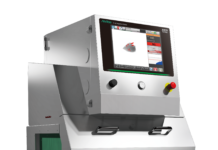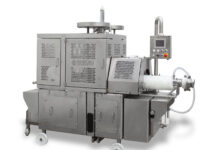 The NIR instrumentations are easy to use and they reduce the risk of human error when measuring the components in the product. The NIR method can also be applied to any type of meat (regardless of species) and at different temperatures (fresh, chilled, etc.). This method is also unaffected by environmental elements such as humidity, illumination and temperature. The instruments are compact and light, easy to use and clean after each measurement. They are equipped with software that can calculate robust calibration algorithms and interfaces that allow easy transfer of data to a PC (for example, USB port) and keep a track record of the production process for each batch. After a certain period of time, the analysis of the archived data allows to track certain trends in the production process, for example, the periods of “lean giveaway”, where the addition of fat to the food preparation has been too low, resulting in a negative economic result for the company. In this way, the implementation of the NIR system guarantees a rapid ROI (Return of Investment). It’s also possible to add a barcode to some NIR systems in order to speed up the process and ensure a higher level of security between the product scanned and the NIR measurements obtained. The initial calibration of the NIR instrument is a very important phase in the process to ensure accurate and sensitive measurements: the optic filters are set in a way to be able to register the levels of absorption at their best, to determine the wavelength of the molecules and to minimize any interfering signals deriving from the food matrix. The four parameters discussed (fat, protein, water and collagen) can be determined at the same time with a unique NIR measurement: each value is listed with a % of the total. The most critical measurement is the collagen, which can be detected in the product only if the percentage is above 1%. Some instruments can be set to highlight the measurements with values outside the specifications of the production process (for example, excessive fat content). Other important factors to ensure correct NIR measurements are homogenizing the sample thoroughly and carrying out multiple measurements (possibly by choosing smaller portions of meat from different parts of the container or the conveyor belt, as far as possible from each other) and then calculate the average value to create a statistical figure. However, in many analytical business plans there will be other accurate compositional analysis at specific times that use classic methods as point of reference: such analysis are often expensive and executed in external laboratories. In general, there is a good correlation between the values obtained with classic methods and those obtained with the NIR instrumentations.
The NIR instrumentations are easy to use and they reduce the risk of human error when measuring the components in the product. The NIR method can also be applied to any type of meat (regardless of species) and at different temperatures (fresh, chilled, etc.). This method is also unaffected by environmental elements such as humidity, illumination and temperature. The instruments are compact and light, easy to use and clean after each measurement. They are equipped with software that can calculate robust calibration algorithms and interfaces that allow easy transfer of data to a PC (for example, USB port) and keep a track record of the production process for each batch. After a certain period of time, the analysis of the archived data allows to track certain trends in the production process, for example, the periods of “lean giveaway”, where the addition of fat to the food preparation has been too low, resulting in a negative economic result for the company. In this way, the implementation of the NIR system guarantees a rapid ROI (Return of Investment). It’s also possible to add a barcode to some NIR systems in order to speed up the process and ensure a higher level of security between the product scanned and the NIR measurements obtained. The initial calibration of the NIR instrument is a very important phase in the process to ensure accurate and sensitive measurements: the optic filters are set in a way to be able to register the levels of absorption at their best, to determine the wavelength of the molecules and to minimize any interfering signals deriving from the food matrix. The four parameters discussed (fat, protein, water and collagen) can be determined at the same time with a unique NIR measurement: each value is listed with a % of the total. The most critical measurement is the collagen, which can be detected in the product only if the percentage is above 1%. Some instruments can be set to highlight the measurements with values outside the specifications of the production process (for example, excessive fat content). Other important factors to ensure correct NIR measurements are homogenizing the sample thoroughly and carrying out multiple measurements (possibly by choosing smaller portions of meat from different parts of the container or the conveyor belt, as far as possible from each other) and then calculate the average value to create a statistical figure. However, in many analytical business plans there will be other accurate compositional analysis at specific times that use classic methods as point of reference: such analysis are often expensive and executed in external laboratories. In general, there is a good correlation between the values obtained with classic methods and those obtained with the NIR instrumentations.
Bibliography
• Accuracy of fat, moisture and protein measurements in meat – White Paper. NDC Infrared Engineering Ltd, 2011
• G.F. Pedulli, Metodi fisici in chimica organica – Principi e applicazioni di tecniche spettroscopiche. Piccin editore, 1996



